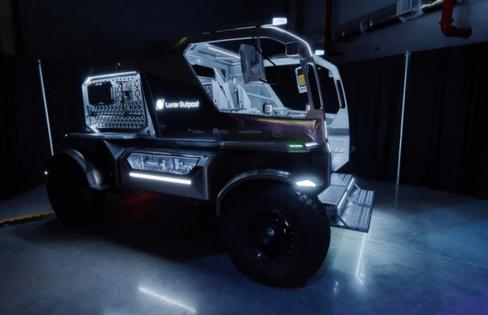Remember the moon rover? Here's a look at a possible Artemis version
Published in News & Features
ORLANDO, Fla. — It’s been more than 18 months since NASA narrowed to three the field of competitors vying to build the nation’s next moon rover.
Ahead of an expected mid-November decision, the teams have completed a series of tests to prove to NASA they have the right stuff for the Artemis missions.
But each company is also intent on showing off the goods, a task that put one prototype rover on display at Kennedy Space Center Visitor Complex recently.
Lunar Outpost came to KSC’s new Gateway exhibit earlier this month for a one-week run, bringing its sleek Eagle to show off amid hardware from fellow commercial space companies like SpaceX, Blue Origin and Boeing.
It has a sci-fi feel with a two-person cockpit augmented with computer display panels with a unique open front design that’s reminiscent of a roller coaster seat.
“I’ve always been passionate about good design. I think that’s important in everything, and certainly in space,” said Lunar Outpost Chief Technical Officer and co-founder A.J. Gemer. “That’s what inspires the next generation, hooks them and makes them want to be a part of it. So we do strive to incorporate good design in everything we do and make it functional at the same.”
For example, each wheel well is set up to be a flat work station, while side-panel storage areas have handy clamped tools like shovels and pickaxes as well as a place to store tubes of collected samples.
The Golden, Colorado, based company, founded in 2017, hopes to be the lunar rover of choice for NASA’s Artemis V mission, the first to feature mobile surface transport, which is on NASA’s road map for 2030. Heading up the Lunar Dawn team, the company is partnered with Leidos, General Motors, Goodyear and MDA Space.
The other rovers vying for the contract include Houston-based Intuitive Machines’ Moon RACER, which stands for Reusable Autonomous Crewed Exploration Rover, partnered with AVL, Boeing, Michelin and Northrop Grumman; and the FLEX rover, which stands for Flexible Logistics and Exploration, led by Hawthorne, California, based Venturi Astrolab partnering with Axiom Space and Odyssey Space Research.
All three won development contracts in April 2024 for about $30 million each, and have since put in their bids for the big prize.
That’s a task order to build the final version of the rover and stick it on the moon’s south pole to await the arrival of the astronauts for Artemis V.
If chosen, Lunar Outpost would get its ride to space courtesy of a SpaceX Starship.
“Of course, the Eagle is fully autonomous and tele-operable,” Gemer said. “So we can drive around, do all of the landing site scouting, mapping, things like that, identify potential sites of interest for the crew before they even arrive.”
The prototype model on display at KSC emerged from earlier versions that went through a series of tests at Johnson Space Center in Texas in late 2024.
All three companies had rover mockups put through their paces by NASA astronauts wearing spacesuits attached to apparatus that mimicked the one-sixth gravity on the moon.
“They gave us thousands of points of feedback on where they liked controls, handholds, field of view, entering and exiting the cockpit,” Gemer said. Adjustment led to the latest model with “a very clean cockpit that gives the crew excellent visibility. It’s very safe. It’s easy for them to climb up into — good hand holds — turn around, position themselves in their seats, and interact with their crew member next to them.”
It was the only one of the three original designs to feature an open front for climbing onboard, although the FLEX rover has since adjusted to follow a similar approach.
Gemer said the open front was for both safety and ease of use.
“Something they told us they really liked was that ability to see what was on the ground, basically right up until they got to it,” he said, noting that lighting at the south pole offers challenges. “There’s very stark shadows, long shadows, things like that. So maximizing that field of view was really important to them.”
The Eagle has a top speed of nearly 16 mph, and would be used by two astronauts on sorties for up to 10 hours.
“We make sure that all of our sensors and onboard computer can map and analyze the area around and provide astronauts real-time feedback on any obstacles or hazards they might be encountering, and really provide them that assisted autonomy,” he said. “So they’re driving. They’re in control the vehicle, but the vehicle is constantly monitoring, keeping them safe and giving them the info that they need in real time.”
Lunar Outpost, like many companies interested in operating on the moon, has worked closely with UCF’s Exolith Lab, which creates simulated moon regolith.
“I love working with UCF,” Gemer said. “My background is in lunar dust science, so I’m quite passionate about getting the best and most accurate simulants.”
Citing budget constraints, NASA intends to select just one commercial provider for the lunar terrain vehicle. That’s a different approach than previous commercial contracts, such as choosing both SpaceX and Blue Origin for the human landing system, or SpaceX and Boeing for the commercial crew program to the International Space Station.
The overall Lunar Terrain Vehicle Services contract is worth a maximum potential value of $4.6 billion and would cover Artemis missions through 2039.
If Lunar Outpost doesn’t receive the first NASA task order, though, it’s moving forward with Eagle anyway, Gemer said. His company already has landed seven contracts for lunar and cislunar (the space between Earth and the moon) missions, including the Australian Space Agency, Space Force and other commercial customers.
“We feel there is significant and sufficient demand for us to deploy Eagle for our commercial customers,” he said. “So we’re going to keep marching forward and building up that infrastructure.”
©2025 Orlando Sentinel. Visit at orlandosentinel.com. Distributed by Tribune Content Agency, LLC.







Comments